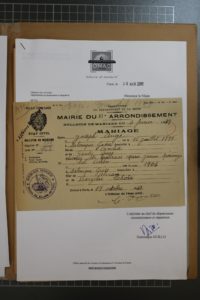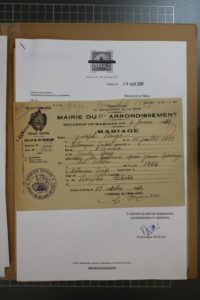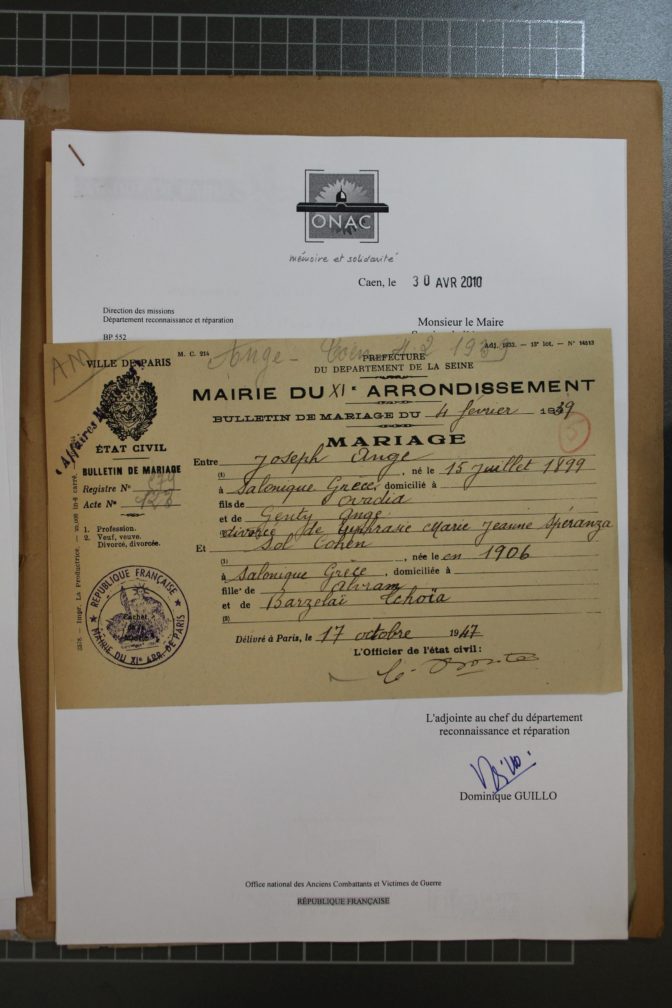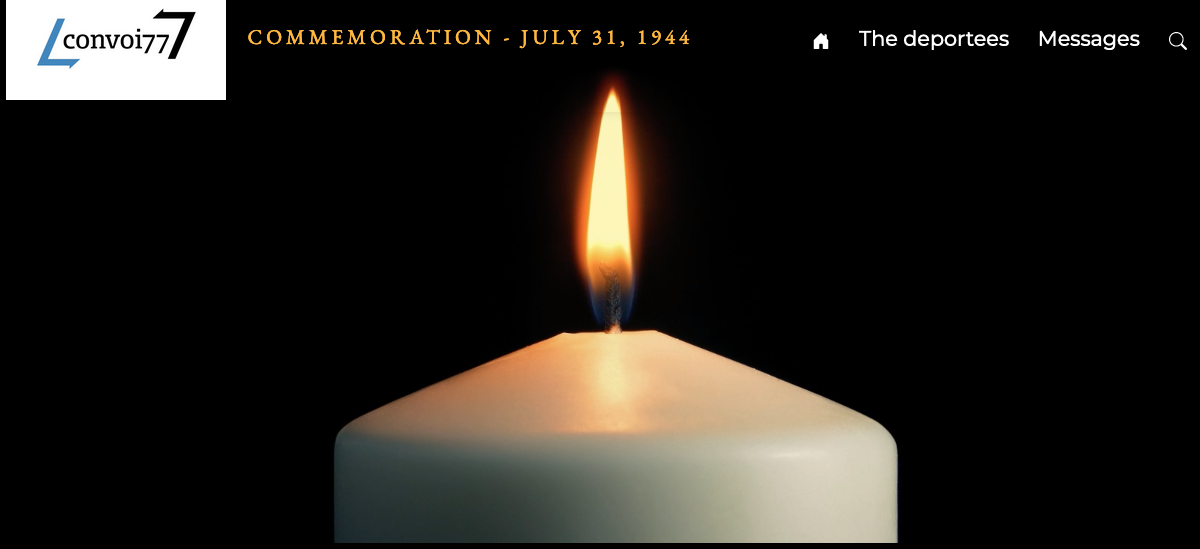Sol COHEN, married name ANGE
Since there are no photographs of Sol Cohen available, we are showing her marriage certificate.
This is the story of Sol Cohen, married name Ange, who was arrested in Paris together with her daughter Juliette in July 1944 and deported to Auschwitz on Convoy 77, the last large transport from Drancy to Auschwitz.
It was written by 9th grade students Leila, Erine, Abdelmalek, Maxence, Mohamed, Brice, Salimata, Ashna, Arthur, Théo, Sarah and Justine, with the guidance of their history and geography teacher, Haphsatou Agne, at the Collège Clagny middle school in Versailles, France.
———————————————————————————————–
Για τους Έλληνες αναγνώστες μας, μετά από το κείμενο στα γαλλικά παρατίθεται η μετάφραση στα ελληνικά.
—————————————————————————————
Sol was born in 1906, on an unknown date, in Salonika, now Thessalonika, in Greece.
She was married to Joseph Ange, who was also from Salonika and was born in 1899.
There is little information available about Sol or her daughter, Juliette. However, the records we studied did provide some information about her husband, Joseph, and the Jewish community in Paris between the wars. This is what we intend to discuss here, as we follow the family’s story.
Who was Joseph Ange?
Joseph was a volunteer in the French Foreign Legion for five years, from 1919 to 1924.
He took part in several military campaigns, in Tonkin, Algeria and Morocco. In 1926, he applied for French citizenship which was granted in 1928 based on his involvement in the Foreign Legion. A letter from Joseph to the Prefecture of Paris mentions his reasons for wanting to become a French citizen: his wife-to-be, Speranza, was French and her family would only agree to let her marry him if he too became French. He thus became one of the 30,000 Jews who were naturalized as French citizens.
Joseph became French according to a decree issued in 1928.
While he was married to Speranza, Joseph was convicted several times, in 1933, 1934 and 1937, for “abandoning his family”. It appears that he had difficulty managing his finances. According to the prefecture, his monthly income was only 1000 francs while his rent 1500 francs. He was ordered to pay his wife 300 francs a month in alimony to support his son, Jacques, who was born in 1941. The couple got divorced in 1938.
The records of the Commissariat Général aux Questions Juives, (Commissariat-General for Jewish Affairs), an organization that had been appointed to manage his affairs, state that Joseph Ange, a former member of the Foreign Legion, was called up for the war in September 1939 and demobilized in August 1940.

Joseph was deported on the first transport from Drancy camp on March 27, 1942. He was among 1162 deportees on Convoy 1, which departed from the Bobigny railroad station bound for Auschwitz. The deportees were men, French citizens, citizens of German-occupied countries and stateless people. They arrived in Auschwitz at 5:33 a.m. on March 30, 1942.
The Jews from Salonika in Paris
Joseph and Sol were both born in Salonika, Greece, in 1899 and 1906 respectively.
Salonika had been part of the Ottoman Empire until 1912, when Greece annexed the city.
It was a prosperous city with connections to the rest of Eastern Europe. Jews made up the majority of the population until the 1930s. After the Great Fire of 1917, the inner city was redesigned, and at around the same time persecution of Jew and their businesses began. It was forbidden to work on Sundays, for example, so Jews had to work on the Sabbath, which is a holy day of rest. The Jews became a minority in Salonika: there were fewer than 100,000 of them at the beginning of the 20th century but only 53,000 after the First World War.
It was then that the Jews of Salonika, victims of the economic downturns and increasing anti-Semitism, began to migrate to Western Europe and America.
When they arrived in Paris, the Jews from Salonika congregated in the east of the city, mainly in the Marais and Bastille districts. The association for the Cultural Affairs of Jews from Salonika was based on rue Lafayette in the 9th district of Paris.
In the 1930s, there were 250,000 Jews in France, of which 150,000 were in Paris and the surrounding area.
Jews were found in all walks of life. Those living in eastern Paris, like Joseph Ange and his family, were mostly artisans and employees. The Paris Police Department described Joseph as a traveling merchant or a fairground vendor. He was also described as a textile, linen and lingerie salesman. He first lived at 73 rue de la Roquette and then at 140 rue de la Roquette in Paris, in the Bastille district, until he was arrested.

Ici, photo de la Rue de la Roquette au début du XX è s
Source: https://www.cparama.com/forum/paris-rue-de-la-roquette-t4413.html
The area around Bastille was a working class neighborhood at that time, unlike the gentrified area that it is today. There were artisans’ workshops and stores on the ground floor of apartment buildings.

Rue de la Roquette, taken from Rue Popincourt (XI°)
Source: Paris Unplugged https://www.cparama.com/forum/paris-rue-de-la-roquette-t4413.html
“Sol Cohen, married name ANGE”
According to the records of the Yad Vashem Memorial (which reflects Beate and Serge Klarsfeld’s research on deportees in France between 1942 and 1944), Sol was already living in France during the First World War, although no further details are available.

Record of Sol Ange’s civil status. Source: Victims of Contemporary Conflicts Archives Division of the Ministry of Defense Historical Service, ref. n° 21P418 370
Sol Cohen married Joseph Ange on February 4, 1939. There is very little information available about her. We only know anything about her through her husband. She was “declared a French citizen by marriage”.

Sol Cohen and Joseph Ange’s marriage certificate. Source: Victims of Contemporary Conflicts Archives Division of the Ministry of Defense Historical Service ref. n° 21P418 370
Several people called Sol Cohen lived in the neighborhood, including a schoolteacher who was deported in 1942.
Sol and Joseph had one daughter: Juliette Ange, born on December 1, 1941.
She and Sol were both arrested at their home on July 19, 1944.
The Shoah Memorial has a copy of the search log from the time Sol Ange arrived in Drancy camp. She had 2770 francs taken from her, which was a significant sum of money at the time.
Reference: https://ressources.memorialdelashoah.org/zoom.php?code=309623&q=id:p_248541&marginMin=0&marginMax=0&curPage=0
Convoy 77, the last of the large convoys
This convoy left on July 31, 1944 carrying 1321 deportees, including 330 children, many of whom were arrested on July 19. It arrived in Auschwitz on August 3, 1944.
Yvette Lévy, an Auschwitz survivor, testified as follows:
“Arriving on the crazy planet. That’s something you can’t forget. The darkness, the floodlights, the men in striped uniforms, the SS yelling, the dogs barking […]”
Among the survivors in 1945, of whom there were 214 from this convoy, there are 146 women. Sol and her daughter never returned after being deported. Their names are inscribed on the Wall of Names at the Shoah Memorial in Paris, on “slab n° 2, column n° 1, row n° 2”.
The German authorities justified the deportation of the 330 children by saying that they it was in retaliation for a “Jewish assassination” in which some German soldiers were killed. In reality, however, they were killed during an ambush set up by Resistance fighters. Thirty cattle cars were brought in to make up the convoy. According to historian Serge Klarsfeld’s timeline, from the Drancy transit camp the prisoners were taken to the Paris-Bobigny railroad station, where French SNCF drivers drove them to the border between France and Germany. German drivers then took over. The train passed through Châlons-sur-Marne, Bar-le-Duc, Metz, Saarbrücken, Frankfurt, Dresden, Niesse, and then went on to Auschwitz.
 The route taken by Convoy 77
The route taken by Convoy 77
Source: https://www.yadvashem.org/fr/recherche/convois-de-france.html
The convoy arrived at the Auschwitz death camp on August 3, 1943.
The youngest child on board was just fifteen days old.
Yvette Levy, a survivor of Convoy 77, recounted the “Selection” process that took place when they arrived at the Auschwitz camp as follows:
“We got to the far end of the platform, […] and we were immediately selected. We were thrown out of the cattle cars, they yelled at us ‘Schnell, raus, los’, we had to leave everything behind, and practically everyone was sorted right away, the healthy or young ones to the left and the others, the women [who were weaker], the children and the older people to the right. We watched as they formed a line, never thinking that they were going straight to… It was something that really hit us, but we didn’t start to realize it until the next day or the day after”.
Sol and her daughter Juliette, who was barely four years old at the time, appear to have lost their lives as soon as they arrived at the camp, or within a few days. Their death certificates, issued by the Paris City Hall, list the date of their death as August 5, 1944, and state that they were “political deportees”, meaning that they were deported for political reasons.
After the war, Jacques Ange, Sol’s stepson, began searching for his family: his stepmother and his half-sister. They were declared missing in 1947.
n 2021, the French Civil Registration service determined the probable date of Sol’s death to have been August 5, 1944.
An decree dated 1945 defines the status of political deportees as follows: “The following are considered to be political deportees: French citizens transferred by the enemy out of national territory, then incarcerated or interned, for any reason other than an infringement of common law. “
In 1948, two categories of victims were defined by law: Resistance members, who were regarded as fighters, and civilian victims, such as Sol Ange.
Links to other sites:
- Centre de Documentation du Mémorial de la Shoah, Paris https://ressources.memorialdelashoah.org/rechav_pers.php
- Insititu international pour la mémoire de la Shoah
https://www.yadvashem.org/fr.html - United States Holocaust Memorial Museum : https://encyclopedia.ushmm.org/content/fr/article/jewish-population-of-europe-in-1933-population-data-by-country
- Musée de la Résistance en ligne:
http://museedelaresistanceenligne.org/media5927-Demande-de-titre-de-dA
 Σολ Κοέν, σύζυγος Ανζ
Σολ Κοέν, σύζυγος Ανζ
Λόγω απουσίας φωτογραφίας της ίδιας, παραθέτουμε το πιστοποιητικό του γάμου της.
Αυτή είναι η ιστορία της Σολ Κοέν, συζύγου Ανζ, η οποία συνελήφθη στο Παρίσι μαζί με την κόρη της Ζουλιέτ τον Ιούλιο του 1944, από όπου και εκτοπίστηκαν στο Άουσβιτς με το Convoi 77, την τελευταία πομπή απέλασης που έφυγε από το Ντρανσί.
Από τους μαθητές της 3ης Γυμνασίου Leila, Erine, Abdelmalek, Maxence, Mohamed, Brice, Salimata, Ashna, Arthur, Théo, Sarah και Justine, υπό την καθοδήγηση της καθηγήτριας Ιστορίας και Γεωγραφίας Haphsatou Agne, στο Γυμνάσιο Clagny στις Βερσαλλίες.
Η Σολ γεννήθηκε το 1906 στη Θεσσαλονίκη. Δε γνωρίζουμε την ακριβή ημερομηνία γέννησής της.
Παντρεύτηκε τον Τζόζεφ Ανζ, επίσης από τη Θεσσαλονίκη, που γεννήθηκε το 1899.
Υπάρχουν πολύ λίγες πληροφορίες για τη Σολ και την κόρη της Ζουλιέτ, αλλά τα αρχειακά έγγραφα που συμβουλευτήκαμε μάς αποκαλύπτουν πληροφορίες για τον σύζυγό της Τζόζεφ και την εβραϊκή κοινότητα στο Παρίσι κατά την περίοδο του Μεσοπολέμου. Αυτές είναι που θα προσπαθήσουμε να παρουσιάουμε εδώ, για να αποτυπωσουμε την τύχη της οικογένειάς της.
Ποιος είναι ο Τζόζεφ Ανζ;
Ο Τζόζεφ υπηρέτησε εθελοντικά στη Γαλλική Λεγεώνα των Ξένων για πέντε χρόνια, από το 1919 έως το 1924.
Πήρε μέρος σε διάφορες στρατιωτικές εκστρατείες: στο Τονκίν, την Αλγερία και το Μαρόκο. Το 1926 υπέβαλε αίτηση για να πάρει τη γαλλική υπηκοότητα, η οποία του χορηγήθηκε το 1928 χάρη στη συμμετοχή του στη Λεγεώνα των Ξένων. Σε μια επιστολή που απηύθυνε ο Τζόζεφ στη Νομαρχία του Παρισιού εξηγούσε τους λόγους για τους οποίους ζήτησε τη γαλλική υπηκοότητα: η οικογένεια της πρώτης συζύγου του (Σπεράντζα) ήταν Γάλλοι και θα δέχονταν τον γάμο με τον Τζόζεφ μόνο αν γινόταν Γάλλος. Έτσι προστέθηκε στους 30.000 Εβραίους που πολιτογραφήθηκαν Γάλλοι πολίτες.
Ο Τζόζεφ έγινε Γάλλος με διάταγμα του 1928.
Κατά τη διάρκεια του γάμου του με τη Σπεράντζα, ο Τζόζεφ καταδικάστηκε επανειλημμένα για εγκατάλειψη της οικογένειάς του: το 1933, το 1934 και το 1937. Φαίνεται ότι δυσκολευόταν να τα βγάλει πέρα οικονομικά, με μηνιαίο εισόδημα 1.000 φράγκα και ενοίκιο 1.500 φράγκα σύμφωνα με τις πηγές από τη Νομαρχία. Είχε βγει απόφαση για να καταβάλλει στη σύζυγό του 300 φράγκα μηνιαίως ως διατροφή για τον γιο του Ζακ, που γεννήθηκε το 1941. Το ζευγάρι χώρισε το 1938.

Όπως προκύπτει από τα έγγραφα των Εβραϊκών Υποθέσεων και τον διορισμένο διαχειριστή της περιουσίας του τον Σεπτέμβριο του 1939, ο Τζόζεφ Ανζ, ως παλαιό μέλος της Λεγεώνας των Ξένων, επιστρατεύτηκε για τον πόλεμο και αποστρατεύτηκε τον Αύγουστο του 1940.
Ο Τζόζεφ εκτοπίστηκε με την πρώτη πομπή απέλασης στις 27 Μαρτίου 1942: η πομπή αυτή με 1162 εκτοπισμένους αναχώρησε από το στρατόπεδο διαμετακόμισης στο Ντρανσί για τον σιδηροδρομικό σταθμό Μπομπινί και έφτασε στο Άουσβιτς στις 05:33 π.μ. στις 30 Μαρτίου 1942. Αυτή η απέλαση στόχευε σε άνδρες, Γάλλους πολίτες, πολίτες κατεχόμενων χωρών από τη Γερμανία ή απάτριδες.
Οι Θεσσαλονικείς Εβραίοι στο Παρίσι:
Ο Τζόζεφ και η Σολ γεννήθηκαν στη Θεσσαλονίκη: το 1899 ο Τζόζεφ και το 1906 η Σολ.
Η Θεσσαλονίκη ανήκε στην Οθωμανική Αυτοκρατορία μέχρι το 1912, οπότε και η Ελλάδα προσάρτησε την πόλη στην επικράτειά της.
Η Θεσσαλονίκη ήταν μια ευημερούσα πόλη με δεσμούς με την υπόλοιπη Ανατολική Ευρώπη.
Οι Εβραίοι αποτελούσαν την πλειοψηφία του πληθυσμού της Θεσσαλονίκης μέχρι και τη δεκαετία του 1930. Μετά τη Μεγάλη Πυρκαγιά του 1917 ο αστικός χώρος αναδιοργανώθηκε και άρχισαν οι διώξεις κατά των εβραϊκών επιχειρήσεων: π.χ. υπήρχε απαγόρευση εργασίας την Κυριακή- οι Εβραίοι αναγκάζονταν τότε να εργάζονται το Σάββατο, ιερή ημέρα ανάπαυσης στον Ιουδαϊσμό. Οι Εβραίοι έγιναν μειονότητα στη Θεσσαλονίκη: από σχεδόν 100.000 στις αρχές του 20ού αιώνα αριθμούσαν 53.000 μετά τον Μεγάλο Πόλεμο.
Από αυτή τη χρονική περίοδο και μετά οι Θεσσαλονικείς Εβραίοι άρχισαν να μεταναστεύουν στη Δυτική Ευρώπη ή την Αμερική, θύματα της οικονομικής κρίσης και του αυξανόμενου αντισημιτισμού.
Στο Παρίσι οι Εβραίοι της Θεσσαλονίκης συγκεντρώνονταν στις ανατολικές συνοικίες της πόλης: στο Μαραί, στη Βαστίλλη: εξάλλου, ο σύλλογος για τις πολιτιστικές υποθέσεις των Εβραίων της Θεσσαλονίκης βρισκόταν στην οδό Λαφαγιέτ στο 9ο διαμέρισμα της πρωτεύουσας.
Κατά τη δεκαετία του 1930 υπήρχαν 250.000 Εβραίοι στη Γαλλία, εκ των οποίων οι 150.000 στην ευρύτερη περιοχή του Παρισιού.
Οι Εβραίοι ανήκαν σε όλες τις κοινωνικές τάξεις. Όσοι ζούσαν στα ανατολικά του Παρισιού, όπως ο Τζόζεφ Ανζ και η οικογένειά του, ήταν κυρίως τεχνίτες και υπάλληλοι. Ο Τζόζεφ σύμφωνα με την Αστυνομική Διευθυνση του Παρισιού ήταν πλανόδιος πωλητής ή έμπορος σε λούνα παρκ. Υπήρξε επίσης καταγεγραμμένος ως πωλητής υφασμάτων, λινών και εσωρούχων. Έμενε στην οδό Ντε λα Ροκέτ 73, αργότερα στην οδό Ντε λα Ροκέτ 140 στη συνοικία της Βαστίλλης στο Παρίσι μέχρι τη σύλληψή του.

Source: https://www.cparama.com/forum/paris-rue-de-la-roquette-t4413.html
Η περιοχή γύρω από τη Βαστίλλη ήταν μια συνοικία της εργατικής τάξης, σε αντίθεση με την ιδιαίτερα εξευγενισμένη περιοχή που είναι σήμερα. Στο ισόγειο των κτιρίων υπήρχαν καταστήματα βιοτεχνών.

Η οδός Ντε λα Ροκέτ όπως φαίνεται από την οδό Ποπινκούρ (XI°)
Πηγή: Paris Unplugged https://www.cparama.com/forum/paris-rue-de-la-roquette-t4413.html
Σολ Κοέν, σύζυγος Ανζ
Σύμφωνα με τα αρχεία του Yad Vashem (το οποίο αναφέρεται στην έρευνα της Beate και του Serge Klarsfeld για τους εκτοπισμένους στη Γαλλία μεταξύ 1942 και 1944), η Σολ βρισκόταν στη Γαλλία κατά τη διάρκεια του Α΄ Παγκοσμίου Πολέμου, αν και δεν υπάρχουν περισσότερες πληροφορίες.

Φάκελος DAVCC του αρχείου SHD αριθμ. 21P418 370
Αρχειακό έγγραφο, η οικογενειακή κατάσταση της Σολ Ανζ
Η Σολ Κοέν παντρεύτηκε τον Τζόζεφ Ανζ στις 4 Φεβρουαρίου 1939. Υπάρχουν ελάχιστες πληροφορίες γι’ αυτήν. Τη γνωρίζουμε μόνο μέσω του συζύγου της. Είχε δηλωθεί ως Γαλλίδα λόγω γάμου.

Πιστοποιητικό γάμου της Σολ Κοέν με τον Τζόζεφ Ανζ, από τον ίδιο φάκελο DAVCC του αρχείου SHD αριθμ. 21P418 370
Αρκετές συνονόματες με το όνομα Σολ Κοέν ζούσαν στη γειτονιά, μεταξύ των οποίων και μια δασκάλα που απελάθηκε το 1942.
Από τον γάμο της Σολ και του Τζόζεφ γεννήθηκε μια κόρη: η Ζουλιέτ Ανζ, που γεννήθηκε την 1η Δεκεμβρίου 1941.
Μάνα και κόρη συνελήφθησαν στο σπίτι τους στις 19 Ιουλίου 1944.
Το Mémorial de la Shoah διαθέτει αντίγραφο του δελτίου καταγραφής προσωπικών αντικειμένων της Σολ Ανζ κατά την εισαγωγή της στο Ντρανσί, όπου έπρεπε να καταθέσει το σημαντικό για την εποχή εκείνη ποσό των 2.770 γαλλικών φράγκων.
Η πομπή απέλασης 77, η τελευταία πομπή απέλασης
Η τελευταία πομπή απέλασης ξεκίνησε στις 31 Ιουλίου 1944 μετά τη σύλληψη 1.321 εκτοπισμένων, μεταξύ των οποίων 330 παιδιά, στις 19 Ιουλίου. Έφτασε στο Άουσβιτς στις 03 Αυγούστου 1944.
Η Ιβέτ Λεβί, επιζήσασα, καταθέτει τα εξής:
« Η άφιξη στον πλανήτη των τρελών. Αυτό είναι κάτι που δεν μπορείς να ξεχάσεις. Η νύχτα, οι προβολείς, οι άνδρες με τα ριγέ κοστούμια, τα SS που ουρλιάζουν, τα σκυλιά που γαβγίζουν […] ».
Από τους 214 επιζώντες αυτής της πομπής απέλασης το 1945 οι 146 ήταν γυναίκες. Η Σολ και η κόρη της δεν επέστρεψαν. Εμφανίζονται στον τοίχο με τα ονόματα στο Mémorial de la Shoah στο Παρίσι: « 2η πλάκα, 1η στήλη, 2η σειρά ».
Η παρουσία των 330 παιδιών δικαιολογήθηκε από τις γερμανικές αρχές ως αντίποινα για μια «εβραϊκή δολοφονία» κατά την οποία σκοτώθηκαν Γερμανοί στρατιώτες. Στην πραγματικότητα επρόκειτο για ενέδρα μαχητών της αντίστασης. Τριάντα βαγόνια κινητοποιήθηκαν. Σύμφωνα με το χρονοδιάγραμμα του ιστορικού Serge Klarsfeld, από το στρατόπεδο διέλευσης του Ντρανσί στον σταθμό Paris-Bobigny, οι Γάλλοι οδηγοί των γαλλικών σιδηροδρομικών γραμμών SNCF μετέφεραν τους εκτοπισμένους στα γαλλογερμανικά σύνορα, από όπου στη συνέχεια μεταφέρονταν με Γερμανούς οδηγούς μέσω Châlons-sur-Marne, Bar-le-Duc, Metz, Saarbrucken, Frankfurt, Dresden και Niesse στο Άουσβιτς.

Διαδρομή του Convoi 77
Πηγή: https://www.yadvashem.org/fr/recherche/convois-de-france.html
Το Convoi έφτασε στο στρατόπεδο θανάτου του Άουσβιτς στις 03 Αυγούστου 1943.
Η Ιβέτ Λεβί, επιζήσασα του Convoi 77, περιγράφει τη διαδικασία της «επιλογής » κατά την άφιξη στο Άουσβιτς:
Το μικρότερο παιδί ήταν 15 ημερών.
Ιβέτ Λεβί:
«Φτάσαμε στο τέλος της ράμπας […] και μας υπέβαλαν αμέσως σε διαδικασία επιλογής. Μας έσπρωξαν έξω από τα βαγόνια, μας είπαν «schnell, raus, los». Έπρεπε να αφήσουμε τα πάντα. Σχεδόν όλες μας αμέσως χωριστήκαμε, οι υγιείς ή οι νέες στα αριστερά και οι άλλες, οι [πιο αδύναμες] γυναίκες, τα παιδιά, οι ηλικιωμένοι στα δεξιά. Είδαμε να σχηματίζεται μια σειρά. Αλλά ποτέ δε φανταστήκαμε ότι πήγαιναν κατευθείαν… Ήταν κάτι που μας σημάδεψε, αλλά αρχίσαμε να το συνειδητοποιούμε την επόμενη μέρα ή μερικές μέρες αργότερα».
Η Σολ και η κόρη της Ζουλιέτ, μόλις τεσσάρων ετών τότε, φαίνεται ότι έχασαν τη ζωή τους κατά την άφιξή τους στο στρατόπεδο ή λίγες ημέρες αργότερα. Το πιστοποιητικό θανάτου που συντάχθηκε από το Δημαρχείο του Παρισιού, για παράδειγμα, δηλώνει τον θάνατό της στις 5 Αυγούστου 1944 και την χαρακτηρίζει ως πολιτικά εκτοπισμένη.
Μετά τον πόλεμο, ο Ζακ Ανζ, γαμπρός της Σολ, αναζήτησε την οικογένειά του: την πεθερά του και την αδελφή του. Κηρύχθηκαν αγνοούμενες το 1947.
Το 2010 το ληξιαρχείο διαπίστωσε ότι η ημερομηνία θανάτου ήταν πιθανότατα στις 5 Αυγούστου 1944.
Το διάταγμα του 1945 καθορίζει το καθεστώς των πολιτικά εκτοπισμένων: « Οι Γάλλοι υπήκοοι που μεταφέρθηκαν από τον εχθρό εκτός της εθνικής επικράτειας και στη συνέχεια φυλακίστηκαν ή εγκλωβίστηκαν, για οποιονδήποτε λόγο εκτός από παράβαση του κοινού δικαίου, θεωρούνται πολιτικά εκτοπισμένοι ».
Το 1948 ο νόμος έκανε διάκριση ανάμεσα σε δυο κατηγορίες θυμάτων: των αντιστασιακών που θεωρούνταν μαχητές και των άμαχων θυμάτων, όπως η Σολ Ανζ.
Εξωτερικοί σύνδεσμοι:


 Français
Français Polski
Polski









